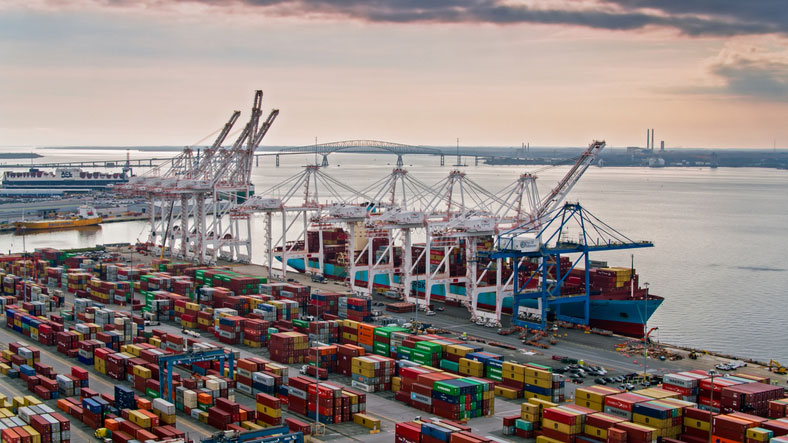Written by Scott Wilson

There’s no doubt that working in supply chain management is exciting.
When a snowstorm locks up a major air freight hub at the same time a longshore union strike shuts down ports along the coast, you can bet you will be scrambling to reroute critical components from overseas suppliers to production points. Negotiating new deals on the fly, rerouting shipments in transit, and getting creative with regional storage sites is all part of a day’s work. It’s fun.
It can also be pretty lucrative. Getting the goods in on time is a critical function in modern organizations.
From government agencies to international relief organizations to Fortune 500 companies, everyone has realized that the supply chain is key to their operations.
For all organizations that depend on robust and efficient supply chains, finding top talent can mean paying top rates.
People who do well in this field tend to be planners by nature. You know what your SCM degree options are, you have your contingencies in place. So naturally you want to know exactly what a supply chain manager makes long before you start taking out student loans.
We’ve got you covered. You’ll find everything here from supply chain management salary rates at the entry level to senior leadership positions reserved for MBA grads. Along the way, we’ll take you through ways in which your education, location, specialization, and experience can impact those rates.
Supply Chain Management Salaries Are on the Rise

After making a big splash on everybody’s radar, supply chain managers are seeing the benefits of suddenly being the most popular people at the party.
Job opportunities skyrocketed for supply chain managers between 2020 and 2021. And they are expected to continue climbing for another decade, hitting almost 30 percent between 2021 and 2031 according to data from the Bureau of Labor Statistics.
When you see that kind of demand hitting any industry, you can be sure there’s not enough slack in the labor market to instantly fill those jobs. And as anyone going into any aspect of business already knows, when supply is low and demand is high, things get expensive. Salaries are no exception.
So How Much Do Supply Chain Managers Make, Really?
You knew when you asked the question that there wasn’t going to be an easy answer.
That’s because supply chain managers work in a wide range of specializations across almost every industry. There’s no way you would expect a logistics specialist in rural Oklahoma to pull down the same kind of coin as the VP for Global Fulfillment working out of San Francisco.
Not only that, but just meeting in the middle of those two pay rates with an overall median figure doesn’t get you any closer to knowing what you can expect to make. Figuring out a supply chain management average salary isn’t any better.
You have to get granular, and you have to get specific.
Here’s where we dive into the details of what supply chain management professionals make. The Bureau of Labor Statistics (BLS) is the government agency that tracks employment data for the American workforce, providing the most current, complete, and accurate salary information available. It provides a good picture of what workers make in different industries and different parts of the country, showing the biggest trends in supply chain management salaries.
Specializations Play a Big Role in Determining Salary Levels for Supply Chain Managers

The supply chain is a long and broad set of processes. There’s a lot of room between a freight dispatcher exploring routes through passes during a Rocky Mountain snowstorm and a procurement specialist sorting through redundant overseas suppliers.
The Bureau of Labor Statistics doesn’t go so far as to offer a full breakdown of all the diverse specializations within supply chain management. There are three BLS categories that encompass all of them, shown here with median salary levels for each:
- Logisticians - $77,520 - This category encompasses the workers who directly analyze and coordinate the operation of an organization’s supply chain. They may be hands-on in the field, handling dispatching, tracking, and allocating resources. Alternatively, they may work in the back office, evaluating patterns, reviewing contracts, and handling quality assurance. They may occasionally occupy low-level supervisory positions in these functions.
- Transportation, Storage, and Distribution Managers - $98,560 - These are the front-line and upper-level managers in supply chain organizations. They oversee the logistics operation, handle interactions with other corporate departments, and develop larger strategies for operations and logistics.
- Top Executives - $98,980 - These are senior leaders in supply chain organizations. They’ve climbed the management ladder so high that their responsibilities place them in the more general category with other corporate leaders. So, the average salary in this category tells you a little less about supply chain jobs specifically than the other categories do.
While these categories give you some sense of the responsibilities and job requirements, they don’t really break things down to the specialty level. For example, you might have logisticians, managers, and executives who are all focused on procurement. They will have different salary expectations than their counterparts working in risk management or in warehousing and storage. Though BLS doesn’t directly address those differences, it does provide salary breakdowns by industry.
Supply Chain Management Salary Expectations Depend on the Degree You Hold

In part, the specialization you end up in will rest on the level and type of education you get in supply chain management. Although it’s probably not impossible, it’s going to be pretty unusual for graduates with an AAS in supply chain management to wind up as COO, and you won’t find too many MBAs down on the docks and in the warehouses.
Careers run a steady course upward, though, and there’s nothing that keeps you from building your education along the way. Mobility between supply chain management jobs is a reality for many.
As a very general rule, you will have no trouble starting out as a logistician with an associate or bachelor’s degree in supply chain management. Work as a transportation, storage, and distribution manager will almost always require at least a bachelor’s, verging on master’s at some organizations. And to become a senior executive, a master’s degree or MBA is the best preparation.
Again, BLS doesn’t offer salary levels by degree, but you can often put two and two together by looking at the common requirements for each of those job categories.
How Logistics and Supply Chain Management Salaries Vary by Industry

Every industry faces a unique market and profit potential. And although supply chains are important everywhere, they can be more critical in some industries than others. There’s also unique levels of expertise and knowledge that are associated with some businesses. That can make supply chain management positions more demanding—and more lucrative.
As noted above, looking at the top executive category doesn’t offer a very clear picture of what’s happening in the supply chain world from industry to industry. But for both logisticians and transportation, storage, and distribution managers, you can get a clear perspective on the top-paying industries:
Five Highest-Paying Industries for Logisticians:
- Securities, Commodity Contracts, and Other Financial Investments and Related Activities - $119,820
- Oil and Gas Extraction - $116,040
- Computer and Peripheral Equipment Manufacturing - $112,170
- Highway, Street, and Bridge Construction - $108,690
- Natural Gas Distribution - $106,650
Five Highest-Paying Industries for Transportation, Storage, and Distribution Managers:
- Computer and Peripheral Equipment Manufacturing - $189,700
- Scientific Research and Development Services - $178,880
- Pipeline Transportation of Natural Gas - $166,560
- Natural Gas Distribution - $158,480
- Semiconductor and Other Electronic Component Manufacturing - $156,640
Some of those are exactly where you would expect to find high-paying supply chain jobs—anything in high-tech is bound to be highly paid. Others may surprise you, but still make sense—natural gas and pipeline projects are high stakes and high value, so naturally they are going to bring in the bucks.
Other highly specialized roles may seem like unlikely places for supply chain managers to ply their expertise. In the investment world, for example, the highest paying industry by far for logisticians, you are probably seeing a handful of highly specialized analysts evaluating supply chain financial performance of public companies for big banks and brokerages.
Looking at the Salary for Supply Chain Managers in the Industries with the Most Jobs

It’s also instructive to look at the industries that employ the most supply chain managers. While the salaries may not hit the same high notes, it’s also a lot easier to find positions in these areas:
Top Five Industries of Highest Employment for Logisticians
- Federal Government - $95,250
- Management of Companies and Enterprises - $86,180
- Management, Scientific, and Technical Consulting Services - $67,330
- Aerospace Product and Parts Manufacturing - $92,290
- Freight Transportation Arrangement - $58,110
Top Five Industries of Highest Employment for Transportation, Storage, and Distribution Managers
- Warehousing and Storage - $101,980
- Truck Transportation - $92,550
- Management of Companies and Enterprises - $146,980
- Merchant Wholesalers, Durable Goods - $97,300
- Federal Government - $114,260
These are the industries where tens of thousands of supply chain managers work. They may be more representative of the typical job in the field than those in the top-paying category… but six figures are still well within reach.
Global Supply Chain Management Salary: Even as Supply Chains Have Gone Global, Salaries are Still Impacted by Your Location in the U.S.

Location can have a lot to do with compensation levels in supply chain management. Salaries aren’t just driven by the purely technical aspects of corporate profit, loss, and value-added. They also have to reflect the realities of what it costs for people to live in different places.
It’s also the case that there’s just more demand for talented supply chain managers in certain areas. Transportation hubs, manufacturing centers, major customs ports… on-site expertise is absolutely required. Companies may pay a premium to get it.
So, you won’t be surprised to see that the top-paying states for these jobs tend to be along the coasts:
Logistician Salaries by State
| Area Name | Employment | Median Salary | Top 25% Earn: | Top 10% Earn At Or Above: |
| Alabama | 5190 | 90480 | 109780 | 127840 |
| Alaska | 520 | 80180 | 105190 | 136750 |
| Arizona | 2850 | 67500 | 88460 | 107950 |
| Arkansas | 1500 | 64590 | 81580 | 103610 |
| California | 25780 | 83210 | 105950 | 132800 |
| Colorado | 3560 | 81330 | 102440 | 132610 |
| Connecticut | 1600 | 75600 | 91410 | 108140 |
| Delaware | 690 | 94950 | 106970 | 137200 |
| District of Columbia | 1180 | 105250 | 135300 | 164090 |
| Florida | 12280 | 62460 | 87300 | 110820 |
| Georgia | 9390 | 73390 | 87360 | 105220 |
| Guam | 100 | 61070 | 75030 | 100650 |
| Hawaii | 420 | 89170 | 107010 | 127110 |
| Idaho | 820 | 49110 | 72820 | 96190 |
| Illinois | 11020 | 65030 | 84810 | 106690 |
| Indiana | 2740 | 72560 | 95220 | 121100 |
| Iowa | 1520 | 80220 | 97170 | 104090 |
| Kansas | 2240 | 56530 | 76890 | 97910 |
| Kentucky | 2150 | 63000 | 80410 | 104420 |
| Louisiana | 1720 | 61560 | 81070 | 103800 |
| Maine | 390 | 82460 | 93800 | 107120 |
| Maryland | 6480 | 96710 | 121060 | 141860 |
| Massachusetts | 3670 | 79990 | 106890 | 141020 |
| Michigan | 7940 | 79810 | 103770 | 125220 |
| Minnesota | 3010 | 76280 | 102470 | 124330 |
| Mississippi | 1030 | 70300 | 85790 | 103230 |
| Missouri | 2760 | 76560 | 96970 | 119590 |
| Montana | 250 | 67620 | 85510 | 118930 |
| Nebraska | 960 | 74650 | 93720 | 119770 |
| Nevada | 760 | 67050 | 77390 | 98530 |
| New Hampshire | 790 | 80870 | 97720 | 108670 |
| New Jersey | 6180 | 90530 | 108610 | 130970 |
| New Mexico | 820 | 78990 | 100240 | 123970 |
| New York | 5390 | 80150 | 102840 | 130030 |
| North Carolina | 6220 | 68410 | 90040 | 110480 |
| North Dakota | 190 | 67920 | 83870 | 103710 |
| Ohio | 8010 | 78220 | 97910 | 117860 |
| Oklahoma | 3740 | 77460 | 94370 | 109910 |
| Oregon | 2020 | 75950 | 87420 | 105620 |
| Pennsylvania | 9010 | 78540 | 96280 | 113780 |
| Puerto Rico | 910 | 44210 | 60880 | 80710 |
| Rhode Island | 530 | 73510 | 91440 | 107700 |
| South Carolina | 4020 | 72420 | 87420 | 104870 |
| South Dakota | 240 | 62330 | 79710 | 100530 |
| Tennessee | 3350 | 63650 | 83930 | 102960 |
| Texas | 17370 | 74280 | 92920 | 113760 |
| Utah | 3260 | 78390 | 96590 | 110090 |
| Vermont | 210 | 77800 | 93820 | 113310 |
| Virginia | 8600 | 80180 | 104330 | 132200 |
| Washington | 3970 | 87610 | 106360 | 136410 |
| West Virginia | 510 | 71310 | 88440 | 106870 |
| Wisconsin | 4040 | 69790 | 84250 | 103820 |
| Wyoming | 90 | 79440 | 94370 | 110090 |
Transportation, Storage, and Distribution Manager Salaries by State
| State | Employment | Median Salary | Top 25% Earn: | Top 10% Earn At or Above: |
| Alabama | 1010 | 99760 | 130980 | 164000 |
| Alaska | 870 | 103470 | 124950 | 150300 |
| Arizona | 2630 | 88710 | 112440 | 151270 |
| Arkansas | 1180 | 92530 | 123230 | 165220 |
| California | 30160 | 98990 | 133630 | 175130 |
| Colorado | 1610 | 114820 | 140960 | 179760 |
| Connecticut | 1900 | 116820 | 162830 | 176120 |
| Delaware | 410 | 137260 | 172490 | 210230 |
| District of Columbia | 500 | 140560 | 176220 | 200870 |
| Florida | 9020 | 98580 | 132030 | 172060 |
| Georgia | 6710 | 101230 | 132780 | 178850 |
| Guam | 140 | 76350 | 92060 | 113650 |
| Hawaii | 390 | 101980 | 127090 | 158580 |
| Idaho | 730 | 76100 | 101270 | 130690 |
| Illinois | 9880 | 100200 | 131870 | 168800 |
| Indiana | 2710 | 90530 | 114640 | 150680 |
| Iowa | 1770 | 85680 | 105000 | 138740 |
| Kansas | 1050 | 96610 | 120880 | 155580 |
| Kentucky | 2680 | 89890 | 116100 | 150780 |
| Louisiana | 1380 | 87950 | 116910 | 151920 |
| Maine | 470 | 83200 | 102210 | 127260 |
| Maryland | 3750 | 99000 | 127750 | 171450 |
| Massachusetts | 4100 | 100160 | 135660 | 170080 |
| Michigan | 6450 | 86930 | 113980 | 152450 |
| Minnesota | 2780 | 103460 | 134840 | 183140 |
| Mississippi | 1220 | 71580 | 102200 | 127640 |
| Missouri | 2030 | 87810 | 122150 | 155370 |
| Montana | 240 | 96010 | 106550 | 138260 |
| Nebraska | – | 102600 | 117450 | 150240 |
| Nevada | 1850 | 79770 | 98940 | 124950 |
| New Hampshire | 430 | 115810 | 150780 | 186440 |
| New Jersey | 5650 | 129070 | 164130 | 208850 |
| New Mexico | 510 | 83740 | 102990 | 130420 |
| New York | 4880 | 120030 | 155180 | 200210 |
| North Carolina | 4600 | 98190 | 125650 | 162410 |
| North Dakota | 140 | 95700 | 121560 | 154230 |
| Ohio | 6370 | 85160 | 115860 | 156710 |
| Oklahoma | 1530 | 78590 | 106690 | 164320 |
| Oregon | 2220 | 82410 | 110410 | 136780 |
| Pennsylvania | 4810 | 100930 | 131870 | 165630 |
| Puerto Rico | 870 | 64250 | 98630 | 135390 |
| Rhode Island | 330 | 94760 | 126880 | 155900 |
| South Carolina | 2700 | 97760 | 128500 | 165000 |
| South Dakota | 280 | 91120 | 108000 | 130070 |
| Tennessee | 4240 | 93790 | 125340 | 163470 |
| Texas | 19270 | 97990 | 130000 | 169530 |
| Utah | 2140 | 84000 | 109180 | 144380 |
| Vermont | 340 | 82660 | 108310 | 135410 |
| Virgin Islands | 50 | 61630 | 79000 | 98610 |
| Virginia | 2670 | 100860 | 128360 | 164020 |
| Washington | 2810 | 110560 | 135950 | 166250 |
| West Virginia | 440 | 83820 | 103500 | 132640 |
| Wisconsin | 2870 | 95430 | 124990 | 164780 |
| Wyoming | 130 | 100300 | 123330 | 152620 |
Of course, in today’s digital world, there are also many important supply chain management jobs that can happen half a world away from the action. You can negotiate contracts, run analytics projects, or come up with new operations strategies from anywhere.
Not everyone is interested in relocating to where the highest salaries are, either. If you want to stay where your roots are, you might still find opportunities out there. A representative sample of different cities around the country will give you an idea of what you can expect to make:
Logisticians
- New York: $93,990
- Los Angeles: $85,300
- Chicago: $69,420
- Dallas: $77,220
- Miami: $61,070
- Saint Louis: $85,440
- Atlanta: $74,580
- Seattle: $97,100
Transportation, Storage, and Distribution Managers
- New York: $142,670
- Los Angeles: $110,830
- Chicago: $113,120
- Dallas: $112,630
- Miami: $112,220
- Saint Louis: $104,980
- Atlanta: $122,690
- Seattle: $126,890
Each of these metros will have a unique breakdown in salary levels based on the specialized needs of the big industries found there. For example, you might find aerospace big in Seattle, while Chicago may have a more industrial manufacturing bias.
Experience is Part of the Formula for Upping Your Supply Chain Operations Manager Salary

The final factor in determining what you can earn as a supply chain manager is one that is common in every field: how much experience you have.
There are just as many variables in play at the upper end of the range with respect to region and specialization as elsewhere. But overall, the top ten percent of logisticians earn more than $124,050, while those in the elite top ten percent of transportation, storage, and distributions management make more than $169,070.
And in the BLS category for top executives, the top earners can push past the reporting ceiling of $208,000 per year. If that sounds low, it probably is—BLS just doesn’t track numbers any higher than that.
It’s worth noting that all these numbers are just straight salary. Total compensation in the upper ranks is often padded out by bonuses, incentive payments, and stock options in some industries. That can stack big numbers on top of those salaries, pushing them toward seven figures in some instances.
2022 US Bureau of Labor Statistics salary and employment figures for Top Executives, Logisticians, and Transportation, Storage, and Distribution Managers reflect national data, not school-specific information. Conditions in your area may vary. Data accessed July 2023.







